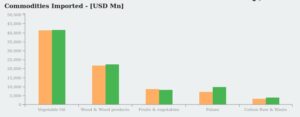The demand for food is expected to spike in the coming years. This raises a fundamental question: Can India feed itself or will it become a large importer of food?
- Major imports in agriculture
- Long Term Agreements
- Import substitution strategies
- One district one cluster
Content:
Major Imports in Agriculture:
- The most frequently imported agricultural products into India are vegetable oils, pulses, fresh fruit, raw cashew nuts, raw sugar, raw cotton and spices.
- Together, the value of these goods accounts for almost 84 percent of all agricultural imports.
- According to official data, vegetable oils account for the largest share of imports

Agriculture Trade Scenario
Since economic reforms began in 1991, India has remained a net exporter of agri-products,
with agri-exports touching 2.52 lakh crores and imports at `1.47 lakh crores in FY 2019-20.
Reasons/Concerns for Import Increase
- Population Growth: India is a country of more than 1.35 billion people. United Nations’ population projections of 2017 say that India is likely to surpass China’s population by 2024 and reach 1.5 billion by 2030, making it the most populous nation on the planet.
- Rise in Food Expenditure: The 2011 consumption expenditure survey conducted by the National Sample Survey Office (NSSO) revealed that an average Indian household spent about 45 per cent of its total monthly expenditure on food.
- This implies that the demand for food in India is going to spike in the coming years.
- Limited Land Resources: India has limited cultivated land (net sown area hovers around 140 million hectares) and its groundwater table is under tremendous pressure, at places depleting at the rate of almost one meter a year.
Climate change predictions indicate rising temperatures and greater frequency and intensity of droughts.
Long Term Agreements:
- India has signed several long term agreements for agricultural imports in the past few years
- In 2016, India and Mozambique signed an agreement where New Delhi will buy pulses from the southern African nation.
- According to the agreement, India will encourage greater production of pulses in Mozambique with an assurance that it will be purchased by India at a mutually-agreed price.
- While India generally has a shortfall of pulses leading to price rise, Mozambique grows the commodity without much consumption locally.
Import Substitution Strategies:
Integrated Scheme of Oilseeds, Pulses, Oil Palm and Maize (ISOPOM)
- Launch Year: 2004
- The first programme on Oilseeds was launched in 1986 as Technology Mission on Oilseeds (TMO).
- Later Pulses, Oil Palm & Maize were brought in its ambit.
- The scheme was later restructured in 2004 as Integrated Scheme of Oilseeds, Pulses, Oil Palm and Maize (ISOPOM).
- To provide further impetus to the production of pulses and oilseeds, the pulses component of Integrated Scheme on Oilseeds, Pulses, Oil palm & Maize (ISOPOM) has been merged with National Food Security Mission and an Accelerated Pulse Production Programme has been launched in 2010.
- Nodal Ministry: Ministry of Agriculture and Farmers Welfare
Key Features:
- Flexibility to the states to utilize the funds for the scheme/crop of their choice.
- Annual action plan to be formulated by the State Governments for consideration and approval of the Government of India.
- Flexibility to the states for introducing innovative measures or any special component to the extent of 10% of financial allocation.
- Involvement of private sector by the State Governments in the implementation of the programme with a financial cap of 15%.
- Flexibility for inter component diversion of funds up to 20% for non-seed components only.
- Diversion of funds from seed components to non-seed components with the prior approval of the Department of Agriculture & Cooperation.
- Increase under staff & contingency not permitted except by revision of pay scale and increase in rate of Dearness Allowance with the prior approval of the Department of Agriculture & Cooperation.
Cultivating Hing in Himachal Pradesh:
- Scientists from the Centre for Scientific and Industrial Research (CSIR) have planted hing saplings in Himachal Pradesh, in the hope that cultivation of the spice will become a common practice in India.
- Farmers of the remote Lahaul Valley in Himachal Pradesh have started taking up cultivation of asafoetida (hing), mainly due to the efforts of the Institute of Himalayan Bioresource Technology, using the vast wasteland in the cold desert conditions of the region, the CSIR said.
- Asafoetida is one of the top condiments and is a high-value spice crop. India imports about 1,200 tonnes of raw asafoetida annually from Afghanistan, Iran and Uzbekistan and spends approximately USD 100 million per year for it.
- Even though India consumes 40 per cent of the world’s hing, no attempt had been made to start its cultivation locally.
- The plant prefers cold and dry conditions for its growth and takes approximately five years for the production of oleo-gum resin in its roots, therefore cold desert areas of the Indian Himalayan region are suitable for cultivation of asafoetida.
One District One Cluster:
- One District One Cluster scheme is aimed at encouraging farmers to adopt the most suitable crop in their district that will help them realise better prices with increased scale.
- Under this, all central schemes in the agriculture sector will be re-oriented with the local demand of farmers in developing a cluster.
- One agriculture or horticulture product already grown in a district or having potential in all parameters like suitable climate and capacity to raise income of farmers will be identified.
- Both the Centre and states will work together to provide necessary market linkage by inviting processors and exporters of that product to source it directly from farmers or through a farmer producer organisation (FPO)
- Introduction
- Mention the major agricultural imports of India
- Discuss the reasons for the rise in imports
- Discuss the imports substitution measures taken
- Conclusion














